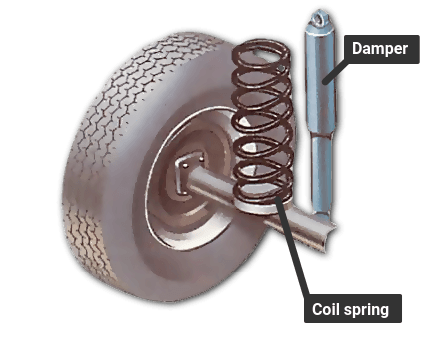Exploring Car Damping Systems: Enhancing Suspension Performance

Introduction:
When it comes to ensuring a smooth and comfortable ride, the damping system in a car's suspension plays a crucial role. This article delves into the world of car damping systems, shedding light on their significance, how they work, and the advantages and disadvantages they offer. So buckle up, as we embark on a journey to understand the ins and outs of car damping!
-
What is Car Suspension Damping?
The suspension damping system, also known as shock absorbers, is an integral part of a car's suspension system. Its primary function is to regulate the motion of the suspension springs, controlling the oscillations generated by road irregularities. By absorbing and dissipating energy, damping systems enhance the vehicle's stability, handling, and overall comfort.
Shock Absorber: An Essential Component
A shock absorber, often referred to as a damper, is a key component of the car's damping system. It works in conjunction with other suspension components, such as coil springs, to provide optimal performance and comfort.
Coil Spring: A Vital Suspension Element
Coil springs, another critical part of the suspension system, work hand in hand with shock absorbers. They help support the weight of the vehicle, absorb impacts, and maintain proper ride height.
How do Damping Systems Work?
Car suspension damping systems utilize a combination of hydraulic and mechanical mechanisms to control the movement of the suspension. When a car encounters bumps or uneven surfaces, the suspension compresses and expands, causing the springs to oscillate. The damping system steps in to regulate these movements and prevent excessive bouncing or rebounding.
-
The Advantages and Disadvantages of Car Damping
Advantages of Car Damping:
- Enhanced ride comfort: Damping systems minimize the impact of road irregularities, providing a smoother and more comfortable ride for passengers.
- Improved stability and control: By reducing excessive body roll and pitch, damping systems enhance the vehicle's stability and handling, especially during cornering and braking.
- Tire traction optimization: Properly tuned damping systems help maintain consistent tire contact with the road surface, leading to improved grip and traction.
- Protection for other suspension components: Damping systems reduce the stress on other suspension parts, such as springs and control arms, prolonging their lifespan.
Disadvantages of Car Damping:
- Cost and complexity: High-quality damping systems can be relatively expensive, and their installation and maintenance may require professional expertise.
- Stiff ride: In some cases, overly stiff damping settings can result in a harsh and uncomfortable ride, transmitting more road vibrations to the cabin.
- Limited adjustability: Some stock damping systems have limited adjustability options, restricting the ability to fine-tune the suspension to individual preferences.
-
Exploring the Four Types of Damping
There are four primary types of damping employed in car suspension systems:
- Velocity-dependent damping: This type of damping adjusts the damping force based on the velocity of suspension movement.
- Position-dependent damping: Damping force varies according to the suspension's position, providing different levels of damping for different suspension travel ranges.
- Proportional damping: The damping force is directly proportional to the velocity or speed of suspension movement.
- Non-proportional damping: Damping force is not linearly related to the suspension movement speed or position.
-
Determining the Best Damping Method
Selecting the best damping method depends on various factors, including the desired ride characteristics, vehicle type, and intended usage. Each damping method offers its own advantages and disadvantages, so finding the optimal balance is crucial.
-
Frequently Asked Questions
Q: What does car suspension damping do?
A: Car suspension damping controls the movement of the suspension springs, regulating oscillations caused by road irregularities and ensuring a smoother ride.
Q: How do damping systems work?
A: Damping systems utilize hydraulic and mechanical mechanisms to regulate the movement of the suspension, minimizing excessive bouncing and rebounding.
Q: What are the disadvantages of car damping?
A: The disadvantages of car damping include cost and complexity, the potential for a stiff ride, and limited adjustability in some systems.
Q: What are the 4 types of damping?
A: The four types of damping are velocity-dependent damping, position-dependent damping, proportional damping, and non-proportional damping.
Q: Which damping is best?
A: The best damping method depends on factors such as desired ride characteristics, vehicle type, and intended usage.
Q: What type of damping is best?
A: The best damping type varies depending on the specific requirements and preferences of the vehicle and driver.
Q: Which damping method is best?
A: The best damping method depends on various factors, including the desired ride characteristics, vehicle type, and intended usage.
Q: Does damping reduce road noise?
A: While damping systems can help reduce vibrations transmitted through the suspension, they may not directly target road noise.
Q: Is damping good or bad?
A: Damping is essential for a well-balanced suspension system, contributing to improved stability, comfort, and handling.
Q: Is higher damping better?
A: Higher damping is not necessarily better, as optimal damping depends on various factors and finding the right balance for specific needs.
Q: How much damping factor is enough?
A: The required damping factor depends on factors such as the vehicle's weight, suspension design, and desired ride characteristics.
Q: What is the damping ratio for racing cars?
A: Racing cars typically employ stiffer damping settings and lower damping ratios to enhance their performance and handling capabilities.
Q: Does damping affect acceleration?
A: Damping can indirectly affect acceleration by minimizing excessive weight transfer and maintaining better tire contact with the road surface.
Q: Does damping affect velocity?
A: Damping influences the rate at which the suspension moves, which indirectly affects the vehicle's velocity during dynamic maneuvers.
Q: Can damping reduce vibration?
A: Damping systems can help reduce vibrations transmitted through the suspension, enhancing ride comfort and reducing unwanted oscillations.
Q: Will damping reduce engine noise?
A: While damping systems primarily focus on controlling suspension movement, they may help minimize vibrations that could contribute to cabin noise.
Q: Does damping remove energy?
A: Damping systems do not remove energy; instead, they convert the energy of suspension motion into heat, dissipating it effectively.
Key Takeaways:
- Car damping systems, including shock absorbers and coil springs, play a crucial role in enhancing stability, comfort, and handling.
- Damping systems regulate the movement of suspension springs, controlling excessive bouncing and rebounding caused by road irregularities.
- Advantages of car damping include improved ride comfort, enhanced stability and control, optimized tire traction, and protection for other suspension components.
- Disadvantages include cost and complexity, the potential for a stiff ride, and limited adjustability in some systems.
- There are four primary types of damping: velocity-dependent, position-dependent, proportional, and non-proportional.
- The best damping method depends on factors such as desired ride characteristics, vehicle type, and intended usage.
Remember, a well-tuned damping system is the key to a smoother and more enjoyable ride. So, make sure to consider the unique needs of your car and choose the damping setup that strikes the perfect balance between comfort and performance. Safe travels!


